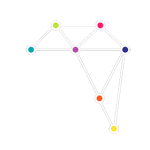LA PRENSA and CONNECTAS
Since October 2020, Juan Pablo has been assigned to surveil Managua’s district six under the command of Alvaro Ramirez, best known as “El Aguila” in the paramilitary ranks. “He is the chief of the district and he tells us which sector to patrol”, Juan Pablo explains, he must comply with his patrol shift from Monday to Friday starting at 8 p.m. and until midnight.
On Saturday, he patrols from 2 p.m. until 7 a.m. of the following day. He rests on Sundays, but he is always on call, he may get a call for a “mission” at any moment, he says.
Once he reports for work, El Aguila gives him a motorcycle, a radio, two magazines and a handgun that he must return when his shift ends. “It is a Magnum”, he specifies.
Juan Pablo is part of a network of armed civilians who many regard as paramilitaries and that works in parallel with the National Police of Nicaragua, as this investigation by La Prensa and CONNECTAS reveals. His main goal is to chase and capture Nicaraguans who oppose Daniel Ortega and his wife, Vice-President Rosario Murillo, Juan Pablo adds.
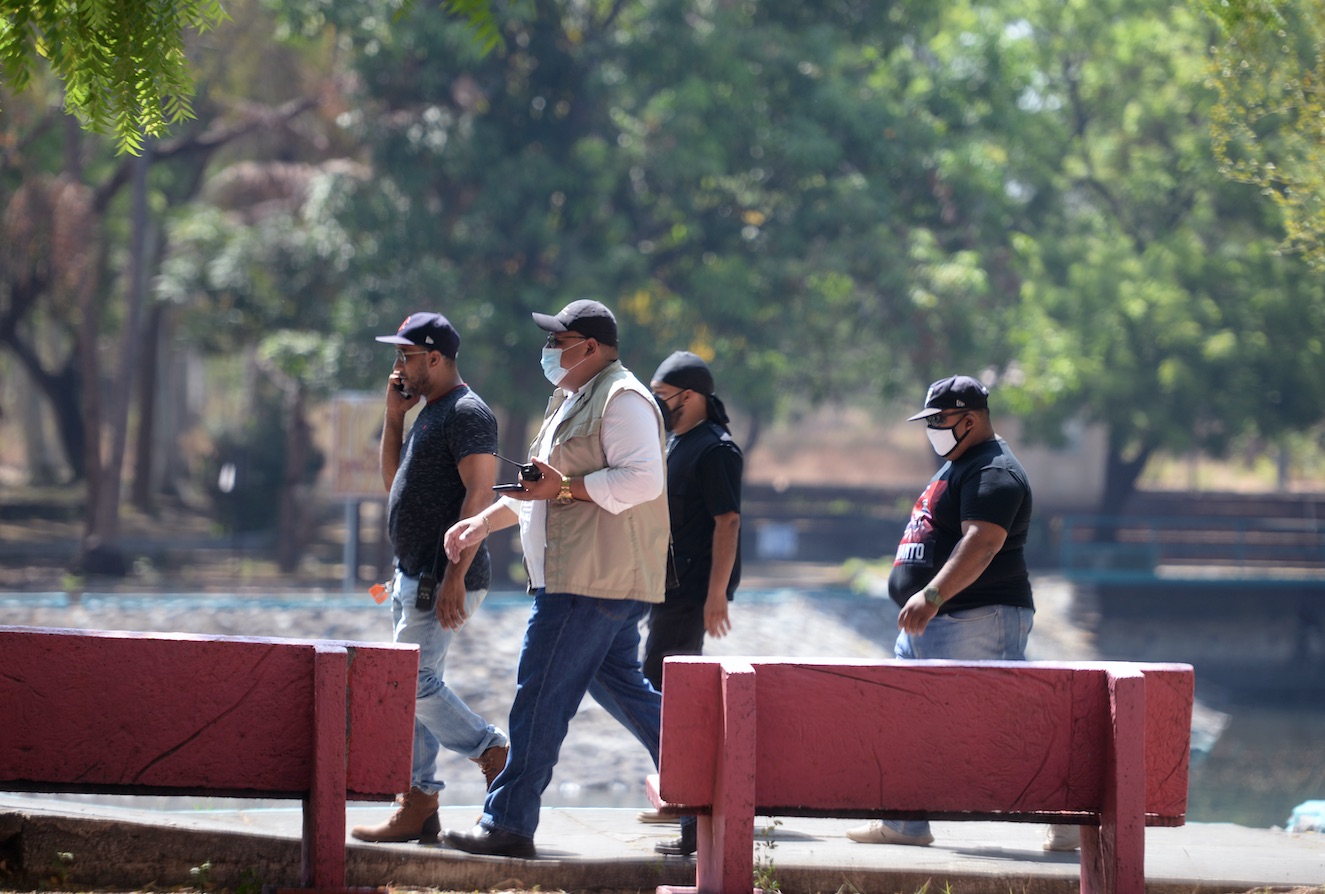
Armed paramilitaries are disguised among civilians in Nicaragua, they carry a radio to be in touch with each other. Photo: La Prensa.
Paramilitaries are given a specific task by their chiefs, such as surveilling a particular member of the opposition, confirming the exact address of a person or keeping him or her under surveillance. In recent weeks, Juan Pablo has been asked to do rounds in some neighborhoods, in case he spots someone that looks “suspiciously” as a member of the opposition, he must contact other paramilitaries on the radio to intercept that person.
“We check for guns and ask what he/she is doing. We ask for identification, take a photograph of the document and write down the name and address of the person,” Juan Pablo says. The data are verified with the National Police to confirm if the person is circulating as part of the opposition.
Juan Pablo explains that in order to know if the person is in the opposition or not, they check their cell phone and social media, if they find images or posts against Daniel Ortega, the order is to detain the person and deliver him/her to the Police. Another reason to be considered part of the opposition, he says, is if they are carrying the flag of Nicaragua, posters, banners, t-shirts or any paper with a message against the President written on it.
There is a different task each night. When “El Aguila” orders him to surveil a specific person in the opposition, Juan Pablo has to find out about their routine, people they meet and places they visit. He also investigates their family, jobs or university, if he/she is a student. Once the information is collected, “the operation is assembled and they go for it. That is what happened to Lesther Aleman (political prisoner), for example”, the paramilitary comments.
He says he doesn’t get paid to do this but if he refuses to work with the paramilitaries he could be accused of treason and be sent to prison. “It has been done to others. We are told to be committed to the Revolution,” he explains.
The paramilitary network at the service of Daniel Ortega has been operating in Nicaragua since 2018, when the population rose against the President and demanded his resignation. The Sandinista leader responded with a brutal repression of the demonstrations with police and paramilitary forces. The final balance, according to the Inter-American Commission on Human Rights (IACHR) was of at least 355 people murdered.
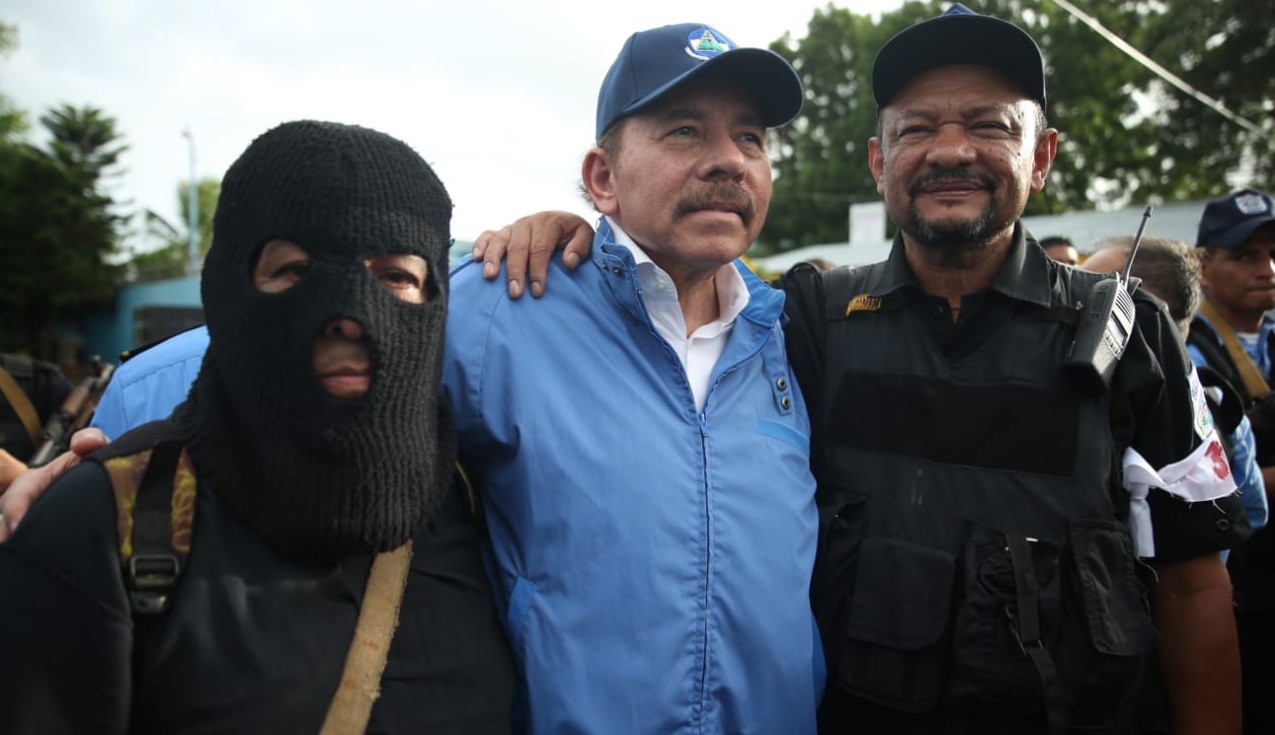
Daniel Ortega and the Commissioner of the Police of Nicaragua, Ramon Avellan, with a hooded paramilitary. The photograph was taken on the day of “Operación Limpieza” in Masaya. Photo: El 19 Digital.
The Paramilitary Structure
For Elvira Cuadra, sociologist and expert in security, “Paramilitary groups have their own chain of command” that operates apart from the National Police, but they don’t act on their own, they follow political guidelines.
Paramilitary Marlon Gerardo Saenz Cruz, alias “Chino Enoc”, says that the structure was initially lead by Raul Venerio Granera, a guerrilla commander and former Chief of the Sandinista Air Force, who went by the pseudonym “Willy”. Venerio directed the Force along with Eden Pastora, Leopoldo Rivas and Glauco Robelo, the general of the brigade in retirement.
Following the deaths of Venerio in June 2019 and of Pastora in June 2020, Leopoldo Antonio Rivas Alfaro began leading the paramilitaries’ Mando Nacional, and Robelo was appointed second in command. As such, Rivas gets his orders directly from Daniel Ortega and his wife and Vice-President Rosario Murillo.
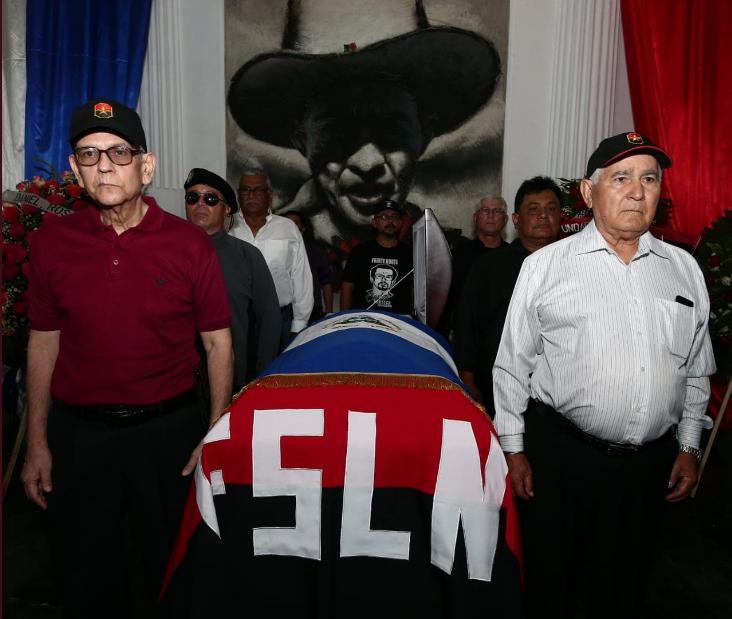
To the left of the coffin, Leopoldo Rivas Alfaro, and to the right, Eden Pastora; in the funeral of Raul Venerio Granera in June 2019.
Rivas Alfaro is an individual with a lengthy trajectory in the Sandinista guerrilla. Nowadays, he is the National Coordinator of service to historical Sandinismo and the Commander of the Sandinista National Liberation Front. By 1974, he was one of the sixteen Sandinistas imprisoned by the Somocista dictatorship. Daniel Ortega was among them too.
On December 27th of that year, an armed command held hostages to demand the release of fourteen of the sixteen imprisoned Sandinistas. Rivas Alfaro was left behind by his comrades due to “suspicions of treason” that lingered on him. He was released from jail on August 22nd, 1978. On that day, another group of the Sandinista guerrilla under the command of Eden Pastora took over the National Palace of Nicaragua, congress people and important personalities of the Somocista regime were taken hostage in the operation, as revealed in the book “El Preso 198”, written by journalist Fabian Medina.
The alleged treason by Rivas Alfaro was never proven, and in 1979, with the Revolution’s triumph over the dynasty of the Somoza family, he was appointed Chief of National Military Services of the Army and Vice-Minister of Defense.
Nowadays, a former police officer who deserted in December 2018 and requested asylum in Costa Rica (which we will call “Renato” for security reasons) explains that below Rivas there are several squads in the paramilitary structure which are directed by former members of the military and historical fighters who remain loyal to the government’s party, they command these groups throughout the national territory.
Some of these names are indeed mentioned by Juan Pablo and by colonel in retirement Roberto Samcam, who met many of them in his years in the Army.
In the western departments of Leon and Chinandega, Renato identifies Camilo Ernesto Baez as one of the paramilitary chiefs; while he claims the chief in Masaya is Alvaro Jose Gonzalez Cerrato, alias “Antolin”, a retired captain.
In Carazo and Rivas, the paramilitary chief is retired mayor Marcos Tulio Navarro Garcia, Samcam asserts. This concurs with the testimony that paramilitary Edgardo Antonio Solis Arias gave to La Prensa in October 2018. Back then, he said that Navarro Garcia “supplied guns and boxes of rounds. They all had shotguns and some carried M16 rifles.”
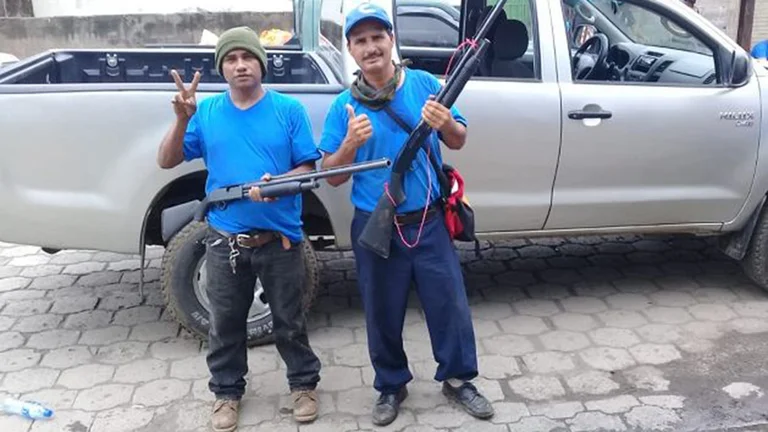
To the left, paramilitary Edgardo Antonio Solis Arias during the “Operacion Limpieza” in Masaya. Photo: Courtesy.
Juan Pablo also identified this paramilitary as one of the chiefs who directed “Operacion Limpieza” in 2018. It consisted of a forceful removal of tanks and barricades that the population had set up to block the main roads of the country as part of the protest against Ortega.
In Chontales, Boaco and Rio San Juan, on its part, the chief of these unofficial armed forces is historical fighter Manuel Antonio Alvarado Fonseca, Renato says. He adds that in Esteli, Madriz and Nueva Segovia, the paramilitary leader is Victor Manuel Gallegos, a retired major who is also known as “Pedrito el hondureño”.
Juan Pablo identifies Sandinista member Luis Hilario Soza Gonzalez, alias “Lalo”, as the paramilitary chief of Matagalpa, as well as Lance Castro in Blufields, in the country’s southern Caribbean coast. He is the son of the Sandinista mayor of that city, Gustavo Castro.
These names, revealed by Juan Pablo, Renato and Samcam, have also been confirmed by other sources of paramilitary groups. They all validated that each of the chiefs has troops to execute the tasks entrusted by the Mando Nacional.
Renato and Juan Pablo estimate, individually, that Ortega’s paramilitary network is currently made up of around 1,000 members. The number grows when adding those “on call”, explains Samcam, which he calculates are around 20,000.
On his part, Saenz doesn’t give a specific number: he says that they are “thousands” and that most are “on call”, as Samcam claims.
Sociologist Elvira Cuadra points out that there were also paramilitary groups in Nicaragua in the years of the Somoza dictatorship, between 1937 and 1979. “As in the rest of Central America,” she claims, but she clarifies that they were smaller than the current structure because these have been directly created by the Sandinista State.
Daniel Ortega has given different explanations regarding these groups. In July 2018, CNN’s journalist Andres Oppenheimer showed him a photo of paramilitaries with flags of the Sandinista National Liberation Front. Ortega belittled them with a sentence: “I could be a photomontage.” Later on, he said that those were “citizens defending themselves”. In an interview with Euronews, days later, he claimed they were “volunteer police officers.”
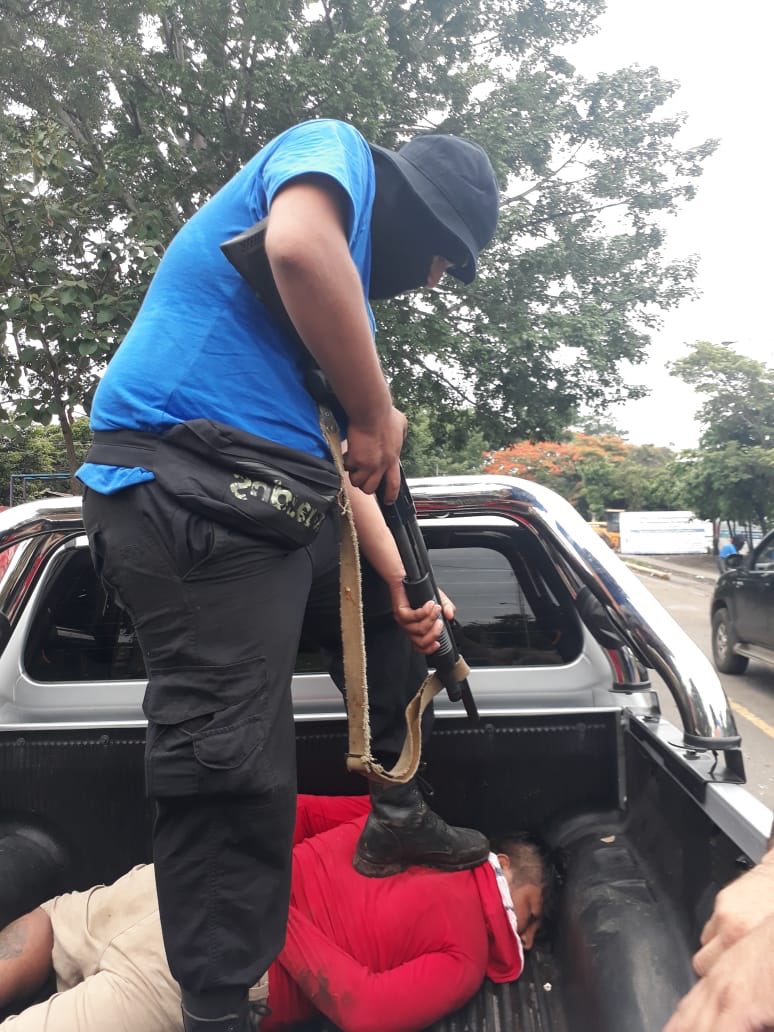
Citizens have denounced being detained by paramilitaries even though Nicaraguan laws state that only the Police can detain a person. Photo: Social networks.
Article 25 of Law 872, pertaining to the National Police’s organization, functions, professional path and special system of social security, indicates that the tasks of volunteer police officers are aimed at “assisting the Police in surveillance, patrolling, transit regulation, and in case of natural disasters”. Also it states that volunteer police forces must be fully identified.
Nevertheless, Ortega’s paramilitary network does not look like a group of “volunteers”. They are not identified as police officers and they operate as civilians.
Although they are not allowed to assault, “More than one is robbing. It is easy if you are armed and on a motorcycle,” Juan Pablo claims.
-Have you stolen from anyone? – we asked him.
– No, I haven’t. What we do sometimes is that when someone is detained, we can steal from him/her and then we split it.
The Police Aren’t Enough
Prior to the paramilitaries, shock groups operated alongside the National Police. Popularly known as “Sandinista mobs”, these members of the Sandinista Youth were in charge of beating up protesters in demonstrations against Daniel Ortega.
When the protests against the President took place in April 2018, the shock groups were the first to curb the protesters, along with the National Police. But “when police forces and shock groups were surpassed by the magnitude of these protests, Ortega’s government set out to organize paramilitary groups,” Elvira Cuadra explains.
Back in the 80s, before being in the government, the Sandinista National Liberation Front, started out as a guerrilla that fought the Somoza dynasty in the 60s and 70s, it eventually accomplished the triumph of the Revolution on July 19th, 1979. Currently, those who were part of the guerrilla, as well as its collaborators are known as historical fighters.
Four decades after the events, Eden Pastora, alias “Comandante Cero” who died in December 2020, undertook a tour of the country’s main cities with other members of the Sandinista National Liberation Front and retired officers of the Army with the purpose of organizing the present armed paramilitary network based in the streets and sustained by Ortega’s government. Those events took place in May 2018.
El 19 Digital, the official government website, published notes of the meetings held by Pastora with former historical fighters throughout the country in its main cities, such as Granada, Leon, Rivas and Esteli. In some of those meetings, he appears alongside Raul Venerio Granera.
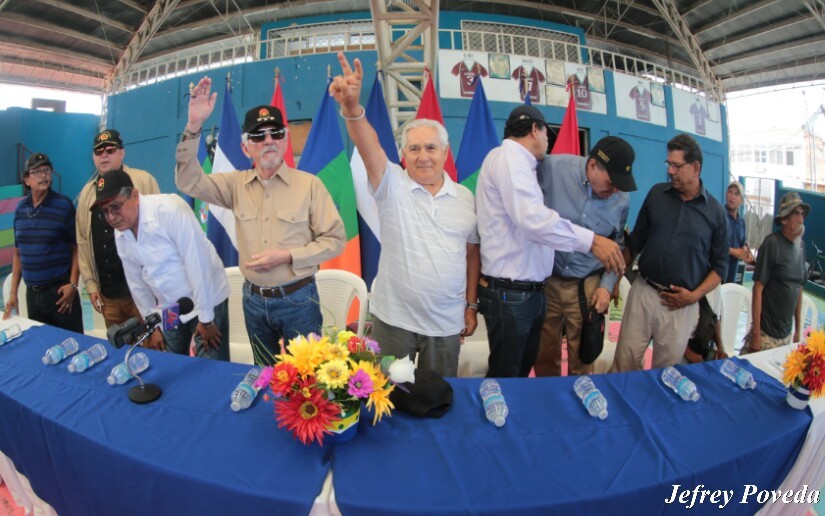
In the center -raising his hand- Eden Pastora, and to his right -wearing glasses and a cap- Raul Venerio, in a meeting with historical Sandinistas in Rivas, in the southern area of Nicaragua. Photo: El 19 Digital.
Marlon Saenz attended a meeting with Pastora in Esteli and recalls discussing the organization of this paramilitary network with them. “We were told that we were going to be the support of the police forces, but at the same time we were going to lead, because the Police have no experience in this matter,” he said.
The configuration of the paramilitaries took a little over a month; they were seen operating jointly with the National Police on June 11th, 2018. On that day, Juan Pablo recalls, Operacion Limpieza began.
Aside of former fighters, the paramilitary groups include public employees, former militaries, members of the Sandinista Youth and gang members, according to the Interdisciplinary Group of Independent Experts, created by the IACHR and Ortega’s government to investigate the violent events that unfolded in Nicaragua between April 18th and May 31st, 2018.
The GIEI (for its Spanish acronym) was composed of Amerigo Incalcaterra, Sofia Macher, Pablo Parenti and Claudia Paz, persons of high technical level and recognized trajectory in the protection of human rights. Their investigation in Nicaragua concluded that Ortega’s government committed crimes against humanity and points to the Police and paramilitary groups as perpetrators.
Juan Pablo remembers that he was recruited in late May that year by the political secretary of the Sandinista National Liberation Front in the State institution where he works. “He told several of us that it was for a task with the Police, that they were going to explain it to us, we were going to receive food and 500 cordobas per day. I attended because otherwise I could lose my job,” he recalls.
That day, June 11th, 2018, “the order was to remove the tanks at whatever cost,” former police officer Renato adds. They began in the eastern neighborhoods of Managua. The plan was devised and had been explained by Eden Pastora himself the night before the operation. “He (Pastora) stayed in a truck three blocks away and he was on the lookout the whole time. He was on the radio with the squad leader to find out about the advance party. ‘Kill those motherfuckers’, he said to us,” the former police officer recounted.
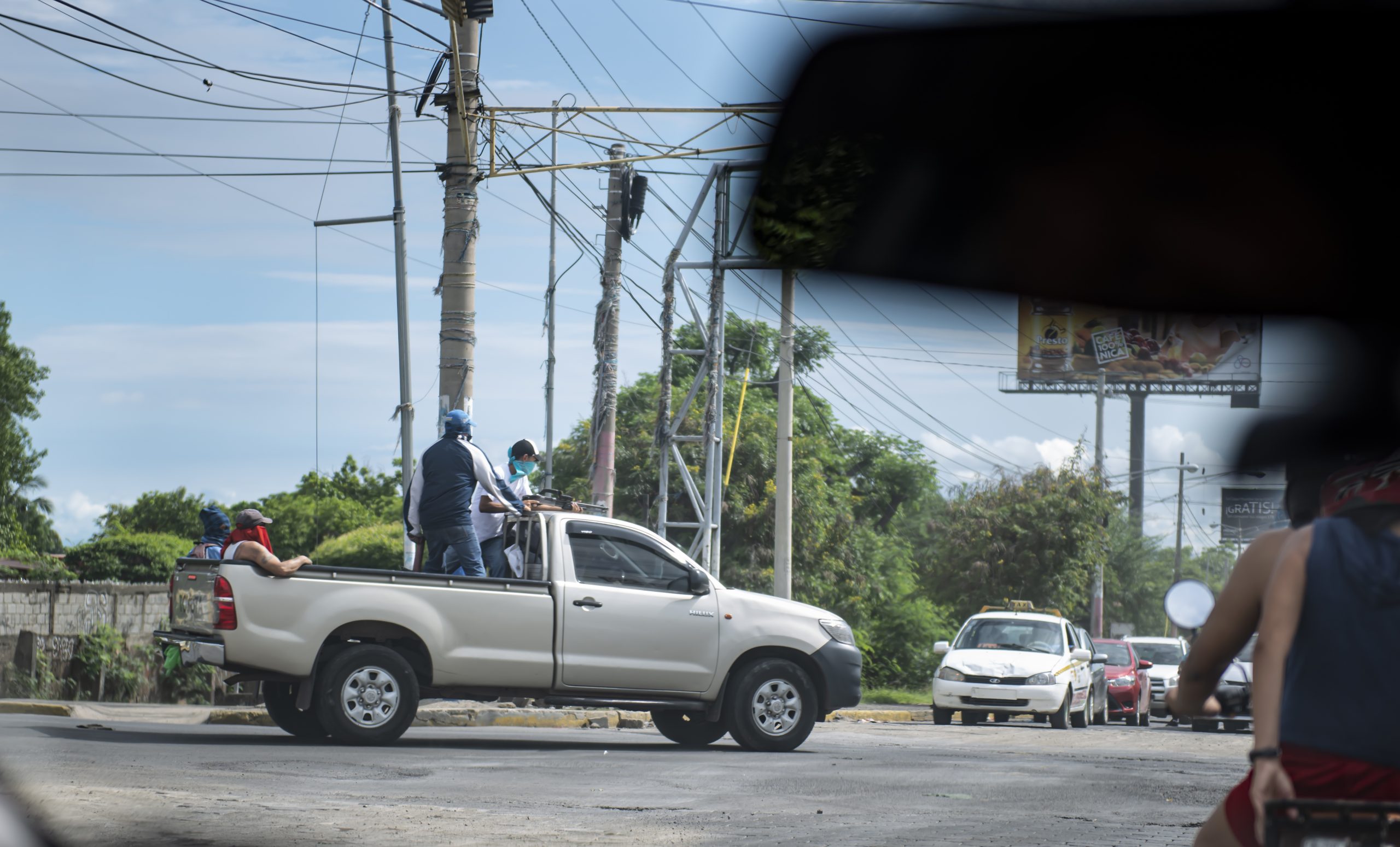
Truck with armed paramilitaries on June 11th, 2018, in the eastern neighborhoods of Managua, the capital of Nicaragua. This is the first armed operation of Sandinista paramilitaries on record. Photo: La Prensa
Pastora’s plan consisted of motorcyclists undertaking reconnaissance in the barricades located in the eastern neighborhoods and, upon their signal, the rest of the squad would move forward shooting to disperse the protesters. “That was when the loader would make way for the trucks to drive in” carrying paramilitaries, Renato explains.
This same strategy was used in the rest of the country in the weeks that followed. Juan Pablo confirms it. He says he was in the Operacion Limpieza in Masaya and Jinotepe, and that the instructions were the same as those received by the group from Renato in Managua.
“Carazo was the largest operation (July 8th, 2018) because three cities were liberated,” Juan Pablo recalls. The operation consisted of attacking the protesters in Jinotepe, Diriamba and Dolores, three cities located in the country’s eastern area. That is where he met Marcos Tulio Navarro Garcia, the leader of the paramilitaries in Carazo and Rivas.
“I didn’t shoot. I didn’t muster the courage to kill people,” Juan Pablo claims. That day has been recorded as the bloodiest day of Operacion Limpieza by the CENIDH (Centro Nicaragüense de Derechos Humanos), with at least 38 people murdered.
Weapons of War in the Streets
Paramilitaries were transported in police patrol cars or in private Toyota Hilux pickup trucks with double cabins, white, black, gray or silver colors. They also used Nissan or Mitsubishi pickup trucks, without licenses, as well as motorcycles. They moved around in motorcades of up to twenty vehicles with 8-15 armed civilians on board each. They left a death trail from city to city, barricade per barricade.
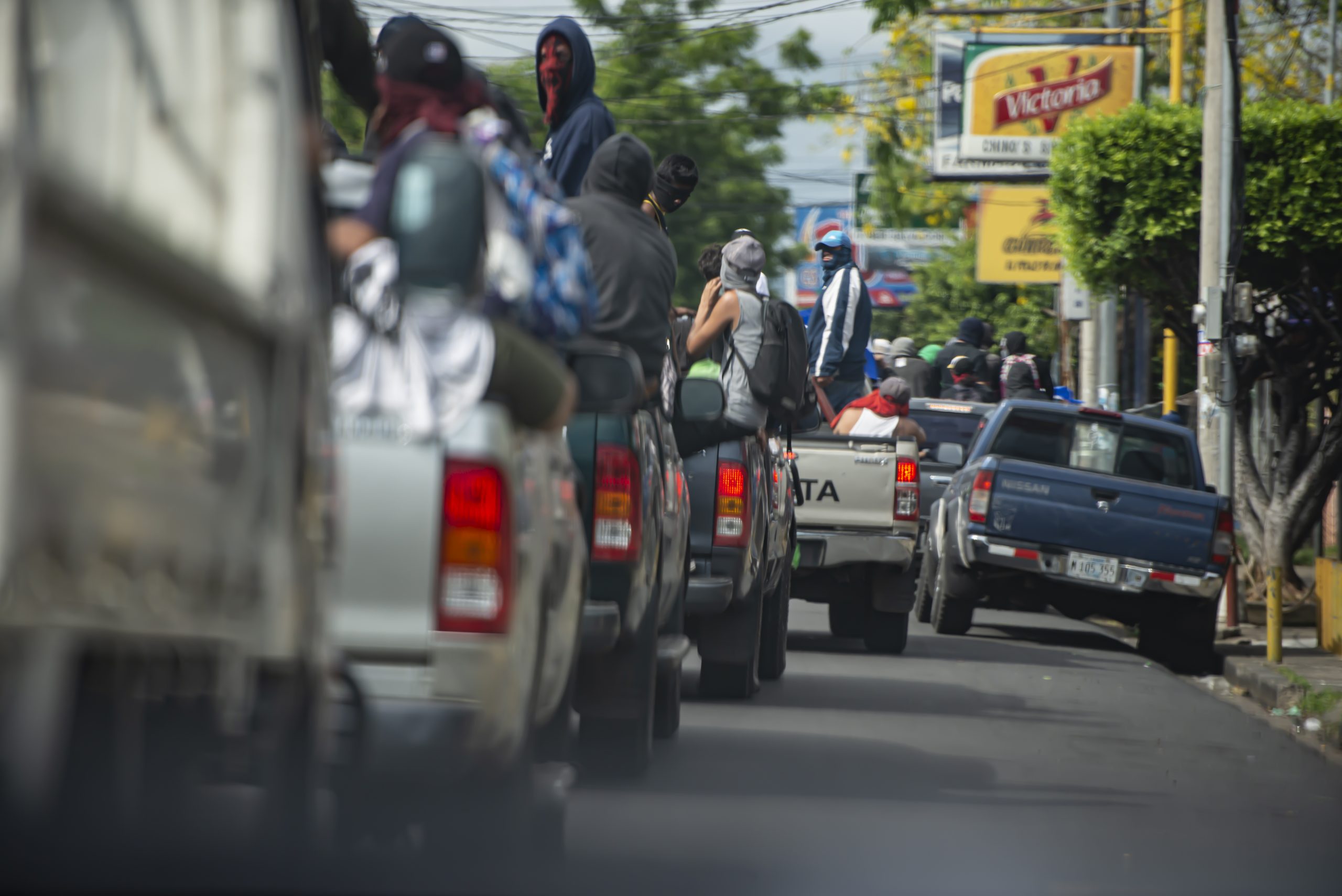
In 2018, the paramilitaries moved around in large pickup truck caravans, the population dubbed them “the squadrons of death”. Photo: La Prensa.
Their faces were covered with ski masks or with their motorcycle helmets, they wore camouflage clothing and an emblem of white ribbons on their arms, which they then changed to t-shirts of different colors. One day the t-shirts were blue, the next white, then black, white and so on day after day. Juan Pablo remembers that in Jinotepe the emblem was a gray t-shirt and a blue one in Masaya.
Additionally, paramilitaries’ firearms drew attention. Criminologist Giancarlo Fiorella analyzed the guns used and he was able to identify at least six types of weapons of war. AK-47, Dragunov sniper rifle, PKM machine gun, M16 rifles, Remington 700 rifles, Jericho 941 handguns and Soviet model bullet magazines with capacity of up to 75 rounds, were among his findings, published in the Dutch website of Bellingcat.
In his conclusions, Fiorella suggests that the TAPIR unit (Unidad de Tacticas y Armas Policiales de Intervencion y Rescate) of the National Police was involved with paramilitary groups.
Moreover, the GIEI identified other guns that were shot in the streets during the violent repression of 2018, such as AK-74 rifles, 12.70 mm shotguns, and .38 mm SPL and 357 Magnum cartridges. Photos disseminated by media outlets also display paramilitary groups armed with RPG7 rocket-propelled grenade launchers. “Those are used by armies to fight wars. These weapons are not made for civilian use because they are designed for war,”, Fiorella comments, adding that some, for instance the PKM machine gun and the Dragunov rifles, require training and not everyone can use them.
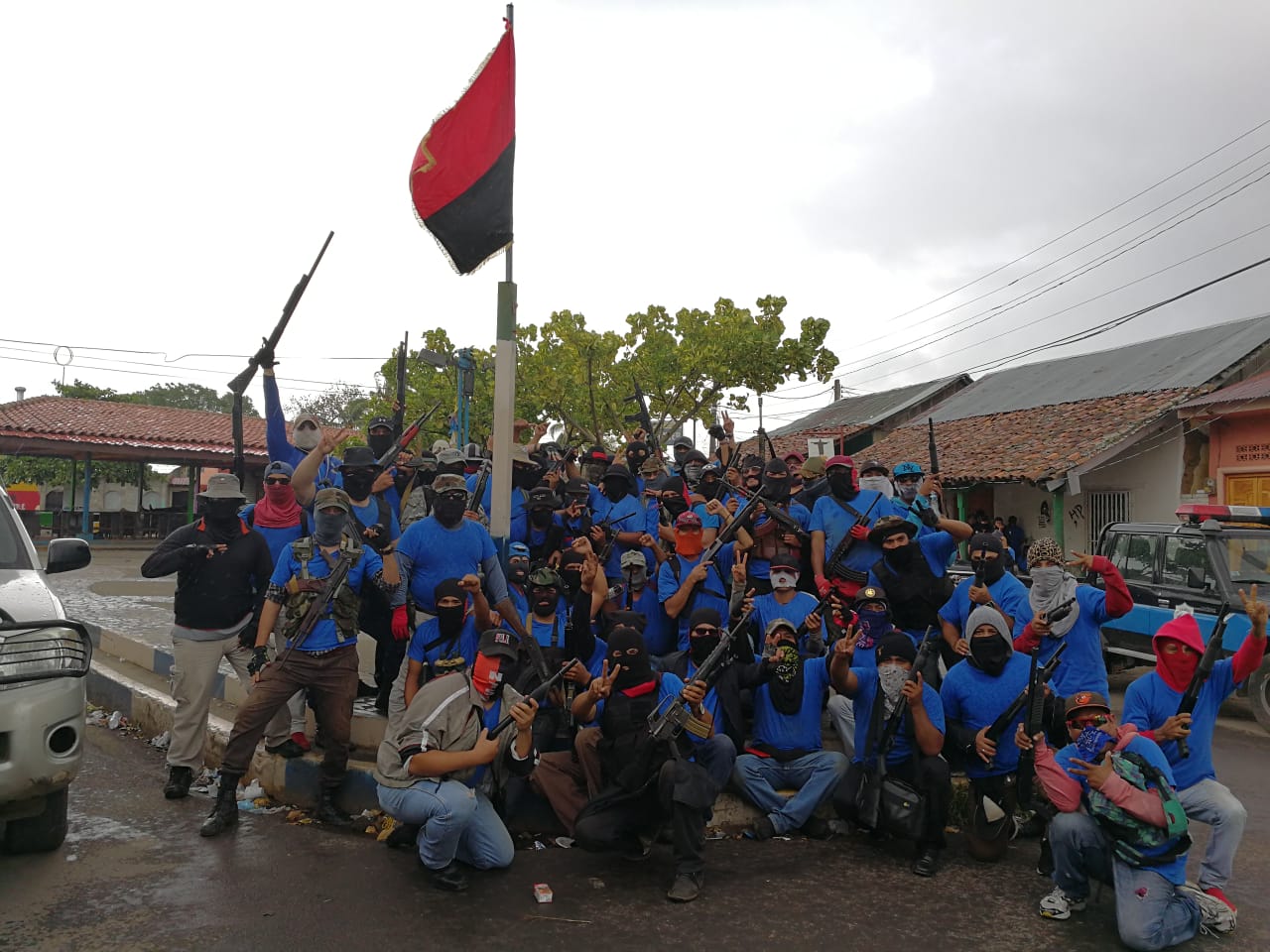
Paramilitary groups pose with their weapons in the Monimbo Square, in Masaya. Photo: El 19 Digital.
These weapons of war “came from the warehouses of the Army” considers Roberto Samcam, colonel in retirement. “We have information from deserters who seeked exile and they suggest that is where the weapons came from. They told us that from the Army warehouses in Xiloa”, he claims.
On its part, the Army has denied the accusations of having put together these groups; they also remain silent about the responsibility they have in terms of disarming them.
Juan Pablo says he is unaware where the weapons came from, but that in any case, it wasn’t until the day of Operacion Limpieza that he was given a shotgun in one of the houses of the Sandinista National Liberation Front. He signed a paper and had to return it by the end of the mission. That is what he does every time El Aguila gives him a Magnum when he has to patrol the streets.
Renato explains that experienced people were given M16 and AK47 rifles, people without experience, gang members and members of the Sandinista Youth received handguns. Weapons of large caliber were given to former military, historical fighters and Police special forces, the former cop claims; he himself was assigned an AK47 rifle and two magazines.
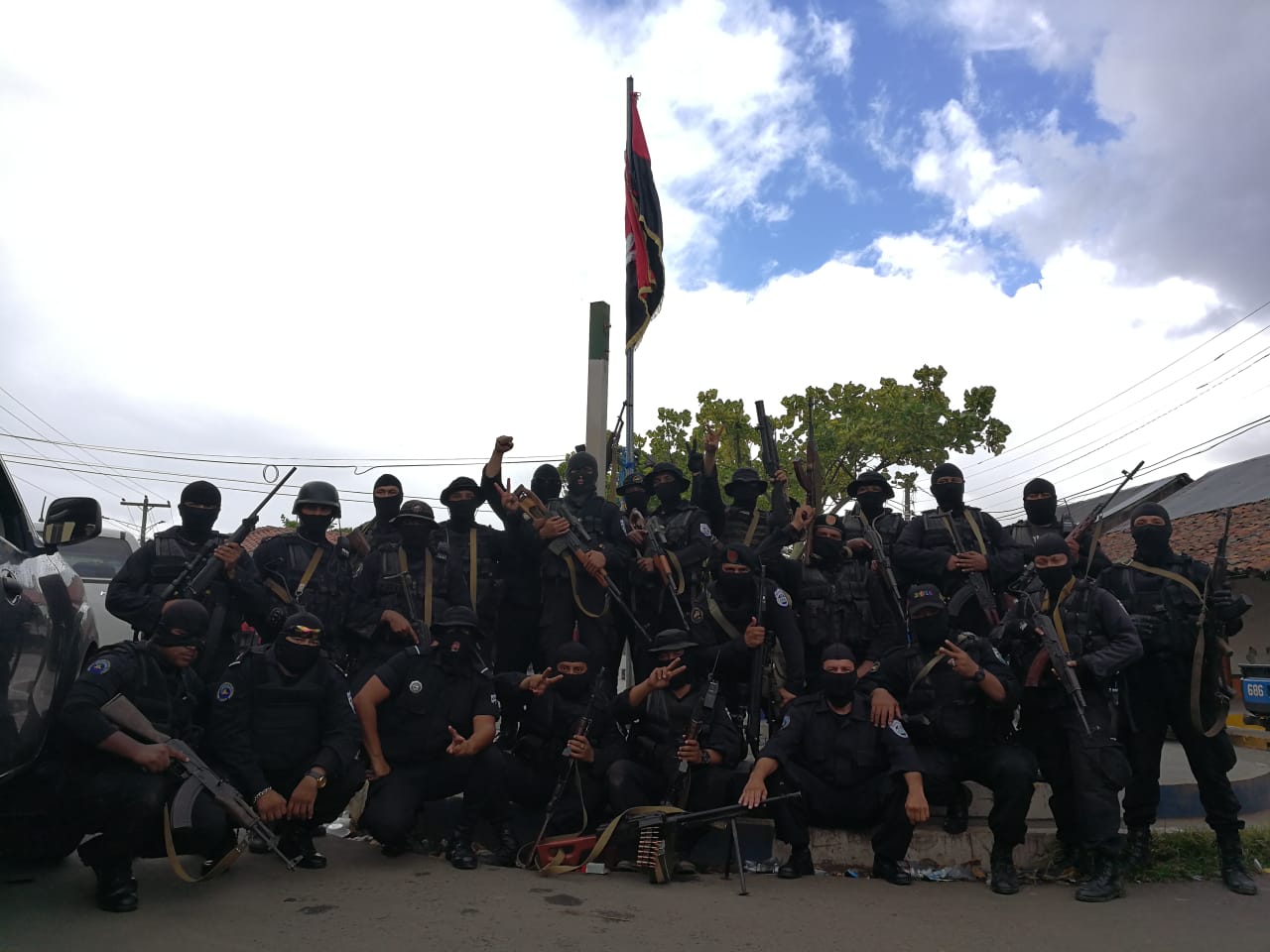
Agents of the DOEP (Direccion de Operaciones Especiales Policiales) in the Monimbo Square in Masaya. The photo shows weapons of war, such as Dragunov rifles and the PKM machine gun. Photo: El 19 Digital.
Marlos Saenz admits that the paramilitaries were armed for what he has called “unblocking brigades”, but he denies they used high caliber firearms. “95% of them were armed with shotguns”, he asserts.
According to Cuadra, these paramilitaries threaten citizen safety because they act with impunity and use high caliber weapons. Even though in recent months they have not been seen with these firearms, they are still available to them, thus it is urgent to dismantle and control this organization. He believes this task corresponds to the Army. “It can’t be relegated or transferred to another institution because none other has the capacity to exert this type of control”, he explains.
New Orders
The last recorded armed attack by the paramilitaries occurred on July 24th, 2018 in the Sandino neighborhood, in Jinotega (in the north of the country); three people were murdered, including a 16-year-old. Since then, the groups have kept a low profile and are in disguise, operating as civilians.
Sociologist Cuadra explains that although the Police and paramilitaries work jointly, they are two distinct forces. That is why detentions, sieges and raids to opponents homes are so frequent in Nicaragua, these are cooperatively executed by police officers and paramilitaries.
But there are other tasks that the paramilitaries undertake on their own. Cuadra illustrates that “if it has to do with threats, harassment, aggression, then the paramilitaries are called” instead of the Police.
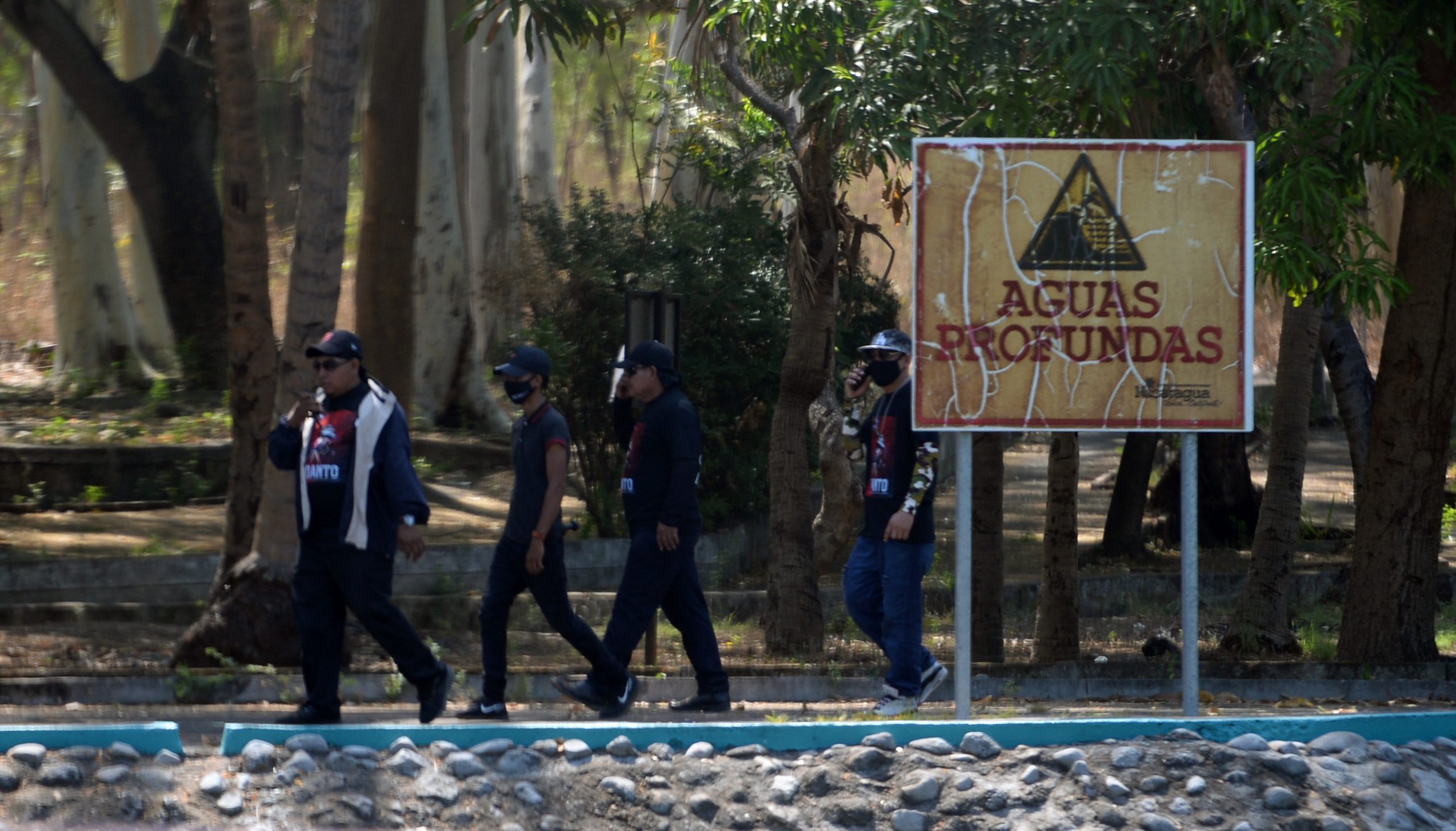
Paramilitaries were seen surveilling last Easter in some of Nicaragua’s spa resorts. This photo was taken in El Trapiche, Tipitapa, 30 kilometers away from Managua. Photo: La Prensa
Criminologist Fiorella concurs and adds that paramilitaries are in charge of the “dirty work” that the National Police can’t do in public. Therefore, they “have a significant place in the government’s oppression toolbox”, he elaborates.
Nowadays, paramilitaries are not operating as in 2018, they have refrained from using weapons of war and ski masks. They cover their faces with their motorcycle helmets. Yet they are easily identified because they carry radios, guns tucked on their waist or lower back. They also wear jackets, t-shirts or caps alluding to the Sandinista National Liberation Front, as captured in photos by media outlets.
The thousand members that currently operate may be complemented with others on call, paramilitary Saenz explains. Juan Pablo says that it takes a single call “to activate them”.
He says that a large number were summoned for the presidential elections of November 7th, 2021, and they formed the UVE (Unidades de Victoria Electoral). “The mission was to prevent protests from whites and blues (opposition). There were no orders to kill as in 2018, but if we say a person protesting we had to detain him or her”, he comments.
Despite not completely agreeing with the repression of Daniel Ortega, Juan Pablo does not dare to desert, as others have done, because he is afraid of retaliation against his family. “We are not foolish. We know things are bad, but we have families,” he says. And that is why he has chosen to continue being a paramilitary and to sleep less than five hours a day.
